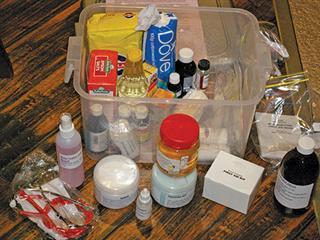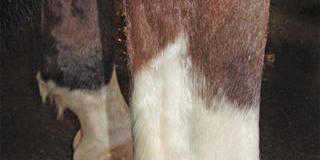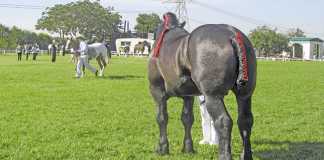
Every horse has basic health parameters, so if you know what is normal for your horse, it becomes easy to recognise a problem early on. For example, I have 16 horses living with me, and each has a different ‘normal’ temperature, ranging from 37°C to 39°C. We take temperatures twice a day – before the horses go out to the fields and when they return. The outside temperature is also recorded.
Temperature
Buy an electronic thermometer for each horse and a pot of Vaseline. Label everything accordingly. Once a week, wipe down all the thermometers with methylated spirits. To take the temperature, stand on the horse’s left side, facing the tail. Lift the tail and insert the thermometer (after it has been dipped in the Vaseline, of course) into the rectum. Push the button and wait. Be sure to hold onto the thermometer – it can slip inside the rectum, although this is unlikely. Make a note of the temperature in a diary. Also use this to write down – on the day it occurs – anything unusual that happens to the horse, from losing a shoe to fighting and biting. This can be of great help to a vet.
See also: Treating tendonitis in horses
Taking the pulse
The horse’s pulse should also be noted. When your horse is in pain, its pulse rate will change. Pulse rate can also tell you if your horse is getting fitter due to work. Find the pulse by running your hand along the jaw line or the fetlock, and feeling for a heartbeat. For the jaw line, run your fingers along the bottom edge of the cheek until you find a group of blood vessels. Gently apply pressure until you feel the pulse. Count the number of beats in 60 seconds.
For the fetlock, feel for the pulse at the back of the fetlock, at the site of the sesamoid bones. Stand in front of your horse, slightly to the side, and place your hands around the fetlock so that your index and middle finger are over the blood vessel, and count the pulse. Alternatively, place your hand flat against the horse’s chest on the left ribcage near the girth area. A normal pulse rate is 25 to 45 beats/minute.
Breathing
Also important is the number of breaths per minute and the manner of breathing. I find it easier to monitor breathing in a stable. A normal horse at rest takes between six and 20 breaths a minute. Every time the rib cage moves out, count. If your horse needs two movements to breathe out, this is a sign of inflamed airways or allergies.Wheezing, squeaking, snoring, or snorting at rest are only normal in aging men; if your horse makes any of these sounds, it’s cause for concern.
Finally, keep the first aid kit in a safe and obvious place. It should comprise a clean water bucket, salt, gauze, cotton wool, gloves, thermometer, scissors, antibiotic spray, Vaseline, torch (with batteries in a zip lock bag), wound dressings, wound gel, poultice, self-adhesive bandages, vet wrap, Ligasano, Elastoplast, duct tape, stable Gamgee and polar fleece bandages, and cooling bandages.
Phone Kim Dyson on 082 888 6511.













